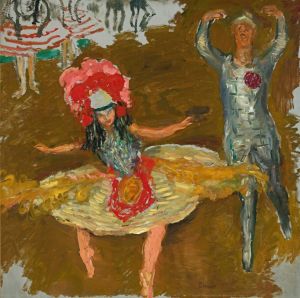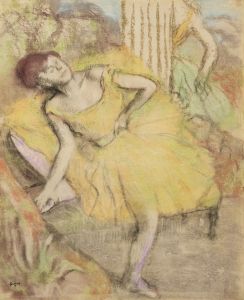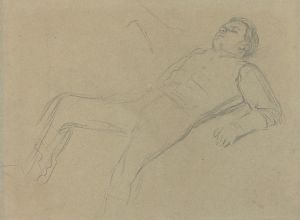
Danseuses à la barre
A hand-painted replica of Edgar Degas’s masterpiece Danseuses à la barre, meticulously crafted by professional artists to capture the true essence of the original. Each piece is created with museum-quality canvas and rare mineral pigments, carefully painted by experienced artists with delicate brushstrokes and rich, layered colors to perfectly recreate the texture of the original artwork. Unlike machine-printed reproductions, this hand-painted version brings the painting to life, infused with the artist’s emotions and skill in every stroke. Whether for personal collection or home decoration, it instantly elevates the artistic atmosphere of any space.
"Danseuses à la barre" (Dancers at the Barre) is a notable work by the French Impressionist artist Edgar Degas, renowned for his extensive exploration of the ballet world. Created in the late 19th century, this painting is part of Degas's series of works that depict ballet dancers, a subject he returned to repeatedly throughout his career. Degas's fascination with ballet dancers allowed him to explore themes of movement, grace, and the discipline of dance, while also providing a window into the private, behind-the-scenes world of the ballet.
Edgar Degas was born in Paris in 1834 and became one of the founding figures of Impressionism, although he preferred to be associated with Realism. His work is characterized by its focus on contemporary life, capturing fleeting moments with a sense of immediacy and movement. Degas's interest in ballet began in the 1870s, and he produced numerous paintings, pastels, and sculptures of dancers over the following decades. His works often depict dancers in rehearsal or at rest, rather than in performance, offering a more intimate and candid view of their world.
"Danseuses à la barre" exemplifies Degas's skill in capturing the human form in motion. The painting portrays two ballet dancers practicing at the barre, a horizontal handrail used for warm-up exercises. The composition is notable for its dynamic use of space and perspective, drawing the viewer's eye along the diagonal line of the barre and the dancers' bodies. Degas's use of light and shadow adds depth and dimension to the scene, highlighting the musculature and poise of the dancers.
Degas was known for his innovative techniques and his ability to convey the physicality and discipline of dance. In "Danseuses à la barre," he employs a muted color palette, with soft tones of pink, white, and gray, creating a serene and focused atmosphere. The dancers are depicted with a sense of realism and attention to detail, reflecting Degas's deep understanding of the human anatomy and his meticulous observation of his subjects.
The painting also reflects Degas's interest in the effects of light and movement. He often used pastels to achieve a delicate, textured surface, which allowed him to capture the subtle nuances of light on the dancers' skin and costumes. This technique is evident in "Danseuses à la barre," where the interplay of light and shadow enhances the sense of movement and the physical exertion of the dancers.
Degas's ballet paintings, including "Danseuses à la barre," have been celebrated for their ability to convey the beauty and rigor of dance. They offer a glimpse into the world of the ballet, revealing both the elegance and the hard work that underpin the art form. Today, Degas's works are held in high esteem and are featured in major art collections around the world, including the Musée d'Orsay in Paris and the Metropolitan Museum of Art in New York.
"Danseuses à la barre" remains a testament to Degas's mastery of form and movement, as well as his enduring fascination with the world of dance. Through his innovative compositions and techniques, Degas captured the essence of ballet, creating works that continue to resonate with audiences and art enthusiasts alike.


















